|
If you had ever wished to time-travel from Lothal of the Indus Valley Civilisation to the Rajiv Gandhi sea link in Mumbai today, looking at, on the way, some of the marvellous creations spanning civilisations – the Mughal invasion, the colonial expansion, and, finally, the 67 years of independent India – you should have spent a long while looking at the 37 panels in the INTACH Exhibition held in Chennai recently showcasing Indian architecture through the ages. The exhibition was conceived by the 82-year-old architect Sarayu Joshi, who took up the project at the request of the Belgian Government when some Belgians asked, ‘What do rock carvings look like?’ Within a budget of Rs. 1 lakh granted by the Indian Government, the architect chose the right mix of examples from the earliest times through to the present on the theme ‘Temples, Forts and Palaces: Splendours of Indian Architecture’ and exhibited them in a small church in Belgium. The same exhibition was what was showcased in Chennai.
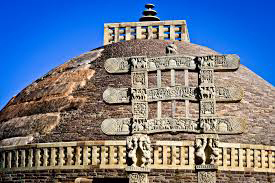
Sanchi Stupa
|
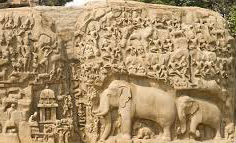
Arjuna's Penance
|
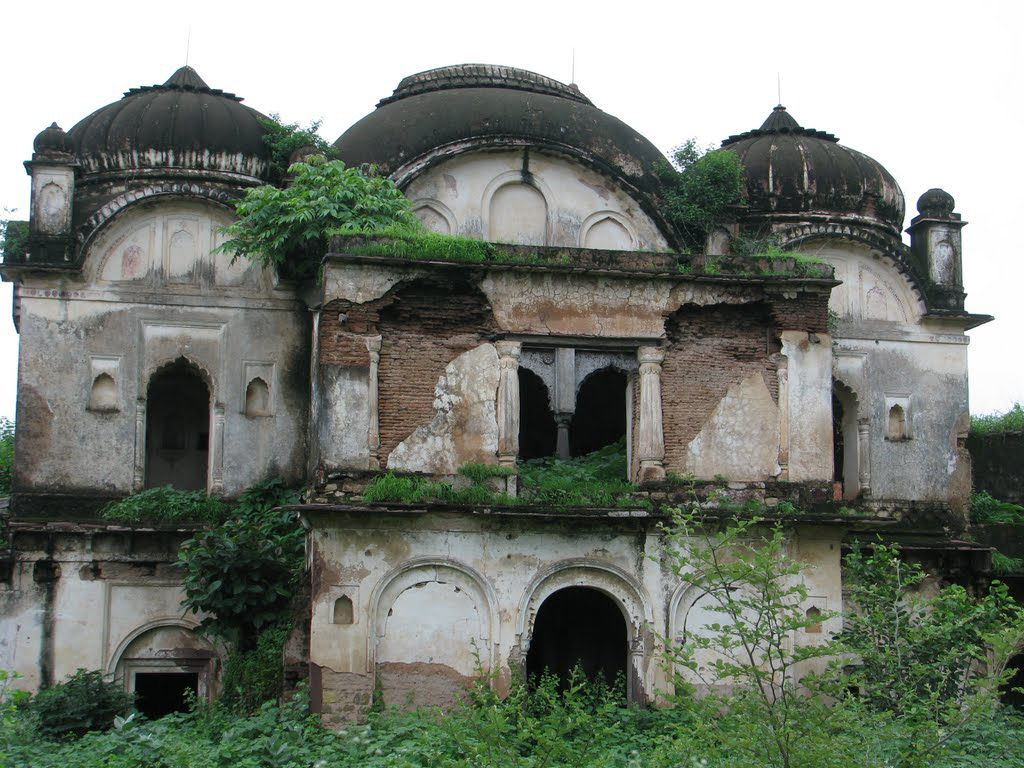
Mandavagarh Fort
|

Humayun Tomb
|
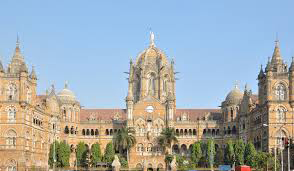
Chatrapati Shivaji Terminus
|
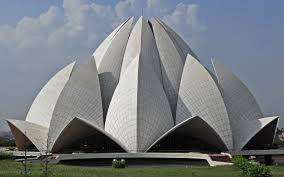
Bahai Temple
|
An introduction to the exhibition said that a synthesis of cultural traditions spanning 2500 years had been covered in the exhibits and “its ethos has been constantly enriched by people of different races and religions who have lived together for generations, each group practising its own religion and way of life.” Each panel had pictures of a monument, a map showing where it is located in India, and a note on the architectural style, its historicity, and the architect, where known.
The remnants at Lothal, dating to the 3rd to the 2nd millennium BCE, during the Indus Valley Civilisation, point to that ancient city being the precursor to modern-day urban planning. Artefacts, steatite seals, human and clay figurines, stone and bronze blades, and cast metal objects were some of the remains shown. Streets laid out in a rectangular grid pattern pointed to town planning even in that era. A long brick-lined rectangular tank could have been a dock for sailing vessels.
Varanasi is considered to be the oldest inhabited city in the world, dating to the 8th Century BCE. Piety here is driven by its 3.5-km-long riverfront and the continuous rows of stone steps, called the ghats, that help the faithful to take a dip in the river’s sacred waters.
The exhibit featuring Sonar Kila in Jaisalmer (c. 1156 CE) urges you to visit Rajasthan to bask in the splendour of the ‘golden glow’ of a fort built with honey-coloured sandstone. And in it are buildings and havelis embellished by ornate carvings and lattice work.
Vijayanagar (14th to 17th Century) was described in 1522 by the Portuguese traveller Paes as the “best provided city in the world.” An area of 60 square miles was covered by “innumerable lakes, waterways and gardens as large as Rome and very beautiful to sight.”
Mandu in Madhya Pradesh, dating back to the 15th Century is now a ghost town and “its romance lives in the ballads of the tragic love of Muslim ruler Baz Bahadur and the Hindu beauty Rupmati.”
The fort of Mandavagarh towers majestically over a part of the Vindhyas, isolated by a deep ravine. The Muslim invaders after defeating the Hindu ruler in 1304 built palaces, mosques, and tombs here in a wondrous architectural style.
Closer home at Mamallapuram is the ‘Descent of the Ganges’ or ‘Arjuna’s Penance’, a grand sculpted frieze adorning a gigantic rockface measuring 30 metres in length and 15 metres in height.
Fatehpur-Sikri represents building art in India attaining its most “sumptuous form” amalgamating Indian and Persian traditions.
The Great Stupa at Sanchi is supplemented with several stupas, each a hemispherical structure with a central chamber enshrining relics of a holy personage.
New Delhi, a creation of the British, designed by Sir Edwin Lutyens and Herbert Baker and inaugurated in 1931, largely reflects the European Palladian style, but incorporates elements of Mughal, Buddhist, and Hindu architecture.
The next set of panels featured cave temples and monasteries, largely a Buddhist tradition where a gracefully sculpted Buddha is the highlight. The Phase I of this architectural endeavour started in the 2nd Century and Phase II was completed in the 7th Century, only to be forgotten and abandoned, till the British, in their hunting expeditions, discovered them in the 19th Century. You travel from the 6th Century Mahesh Murti at Elephanta, a cave temple atop a hill, to the rock-cut Kailasha Natha temple at Ellora of the 8th Century, interspersed with Luna Vasahi at Mt. Abu and the Kandanya Mahadev temple at Khajuraho, which is well known for its sculptural friezes representing erotic postures – all of these combining devotion with breathtaking works of art in mountainous settings.
Rani ki Vav in Gujarat (1068 CE), Tikse Monastery in Ladakh, and the Man Mandir Palace showcase Hindu creations pre-dating the Mughal Qutb Minar and the Jami Masjid in Champaner, Gujarat. Humayun’s Tomb, the finest Muslim mausoleum which, should serve as a model for others, features a char-bagh (an enclosed garden divided into four quarters by water channels representing the rivers of paradise) with the tomb at the centre. Akbar’s Tomb and the Taj Mahal follow Humayun’s tomb in layout and style. Gol Gombaz (1659) is the tomb of Mohammed Adil Shah and symbolises Indian architectural ingenuity and sophistication. Its dome 37.9 metres high is the largest in India. The Great Imambara in Lucknow is a grandiose complex built by Asf-ud-Dauli as flood relief work in 1784.
Then it’s on to the Golden Temple at Amristar (re)built in 1764, after the earlier Hari Mandir Sahib of 1589 had been destroyed by Afghan invaders.
The Convent of St. Francis of Assisi in Goa is representative of the Portuguese creations in the 16th to 17th Century period. Then you visit the Jantar Mantar of 1728 CE in Jaipur, built by Sawai Jai Singh II as a cluster of five observatories and used even today for weather forecasting.
You then, as you move on to the more familiar Chatrapati Shivaji Terminus, a Victorian Gothic architectural style building conceived by the British architect F.W. Stevens, wonder why such an imposing structure was conceived for a railway station.
Without realising it, you are already in the British era, welcomed by Victoria Memorial Hall in Calcutta, an Indo-Saracenic palace-style building showing a romantic and eclectic fusion of European styles with indigenous features such as Mughal domes, central arches and minarets, Buddhist motifs, and Hindu-pillared roof pavilions. You next learn that Chatrapati Shivaji Vastu Sanghralaya is the Prince of Wales Museum, built in 1937. It is another Indo-Saracenic masterpiece combining the stylistic idiom of European features and indigenous style. Then you are at the Falaknuma Palace in Hyderabad, built by an Italian architect, with an Italian marble flourish to it. It is today probably the most starred hotel in India.
From here, the architectural variety moves faster with minimalism predominating, starting with art deco re-lived in the Liberty Cinema in Mumbai. Chandigarh was designed by the French architect Le Corbusier, appointed by Jawaharlal Nehru, who was criticised for imposing Western values on Indian ethos. But the erstwhile province of Punjab needed a new capital after its western half went to Pakistan along with its capital Lahore and Nehru, looking to the future, wanted something modern. The Akshardam Temple is a modern re-creation of temple architecture. The Baha’i temple in Delhi, designed by the Iranian designer Fariburz Sabha, represents a lotus opening its petals at dawn. The 5600-metre-long Rajiv Gandhi Sea Link connecting north Mumbai with south Mumbai is an aesthetically designed engineering marvel built across the sea along the coast. Modern architecture is showcased with architect Charles Correa expressing the modesty of Mahatma Gandhi’s lifestyle in Gandhi Smarak Sanghralaya, a memorial museum to the Mahatma, in Ahmadabad. The Belgian embassy, resembling a fortress of rocky outcrops, designed by Satish Gujral, is another striking piece of modern architecture.
As you leave, you hear the eager voices of children with notebooks in hand, walking around the panels, guided by a teacher. Each school was allotted a slot for viewing the exhibits and a quiz was organised for children when they completed the viewing. They were also asked to sketch any architectural marvel of their choice. These sketches were displayed and the Baha’i temple was the favourite choice. Sujatha Shankar, Convenor of INTACH Chennai, said “We wanted the children to appreciate the richness of Indian architecture and also encourage the visitors to travel to see these monuments,” she added. The exhibition welcomed 3000 visitors.
-K.Venkatesh
|

